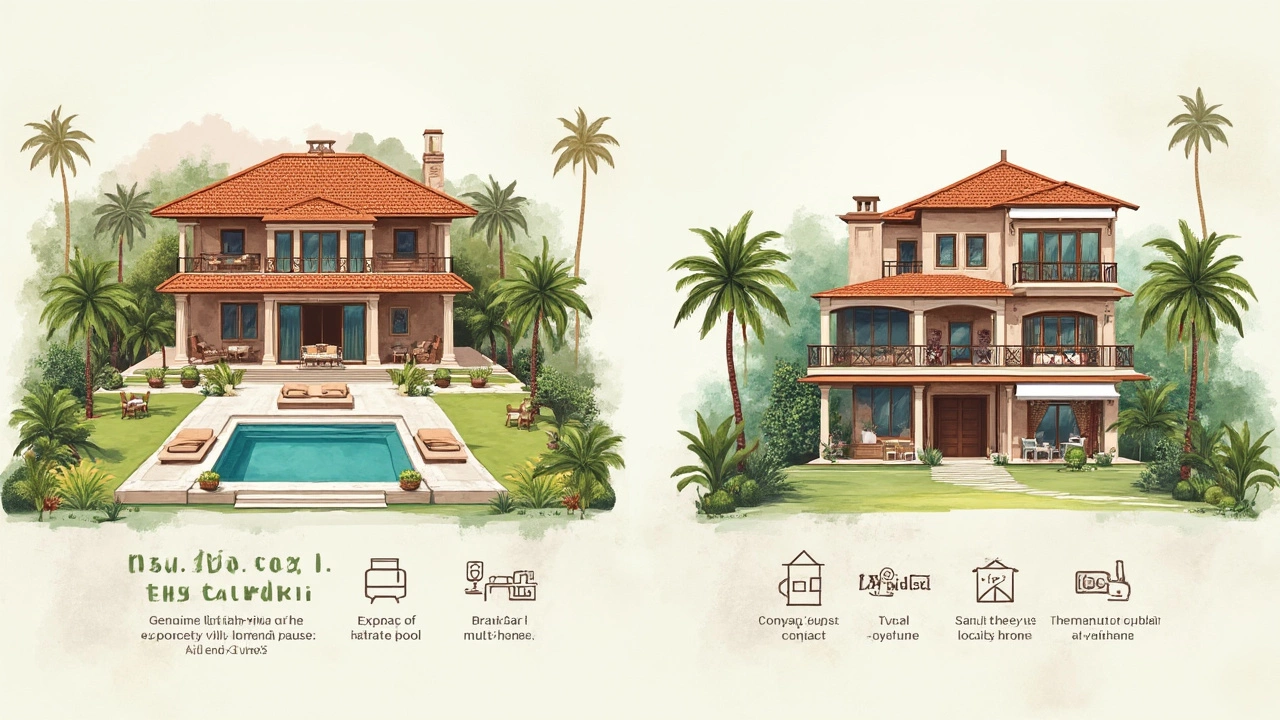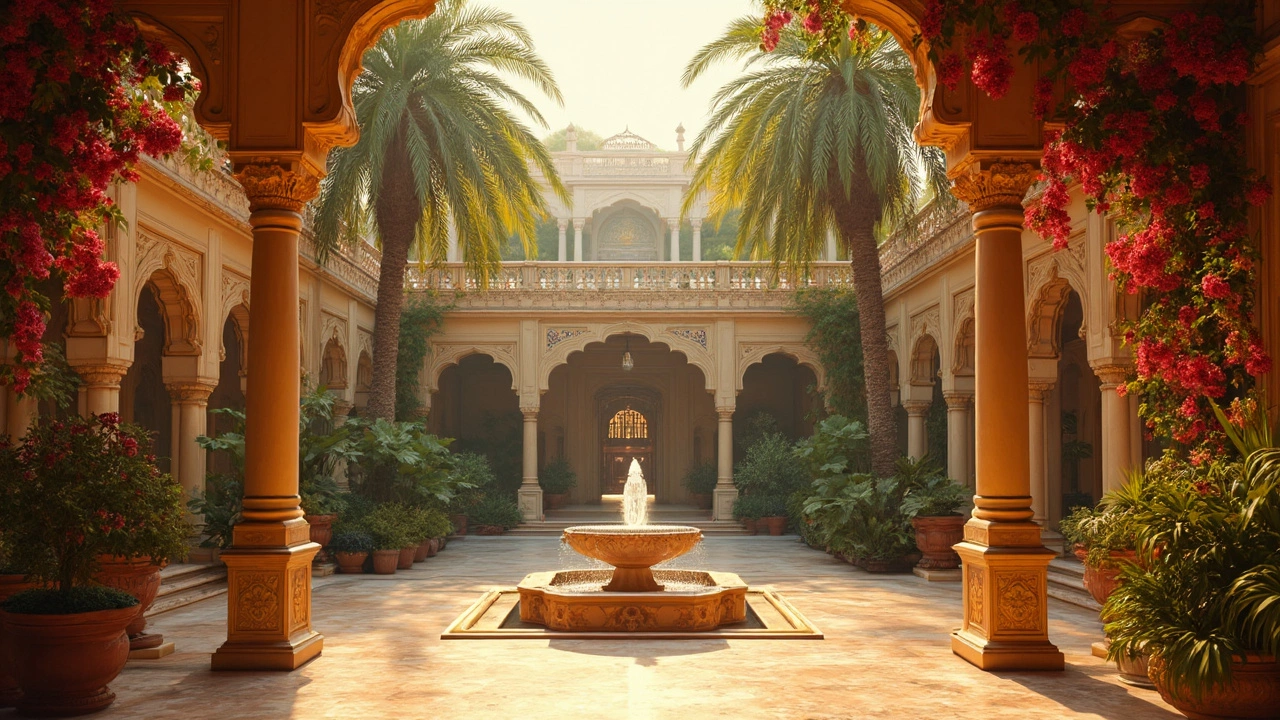The word 'villa' gets thrown around a lot in real estate ads, but what actually makes a house a villa? It's not just about being pricey or having fancy finishes. Villas come with their own vibe and a set of features that make them stand out from regular houses or even mansions.
When you're house hunting, knowing how to spot a real villa can save you time and help you make smarter choices. Maybe you’re picturing lush gardens, lots of space, and total privacy—you're halfway there. Villas aren't about cramming into a corner lot with neighbors peeking in. They’re meant for open living, usually with plenty of outdoor areas for lounging or entertaining.
Let’s break down what sets a villa apart and what to check for if you want a real one. Whether you’re buying, browsing, or just daydreaming, getting clear on what counts as a villa means less guessing and more confidence in your search.
- What Defines a Villa?
- Popular Villa Features to Know
- How Villas Differ Around the World
- Tips for Spotting a True Villa
What Defines a Villa?
If you’re shopping for a villa, you want to know you’re actually getting the real deal, not just a big house with a fancy label. While the word started back in Roman times—think grand countryside retreats with gardens—a modern villa can look pretty different depending on where you look. But there are basics that pretty much always show up.
For starters, space is key. Villas are usually detached homes with way more elbow room than standard houses. You get both indoor and outdoor areas that connect, making it easy to move from your kitchen right onto a private patio or into the backyard for a dip in the pool. Privacy is a big deal too. You’re not staring into someone else’s windows.
Luxury is another common thread, but not always in a flashy way. Villas usually come with quality flooring, updated kitchens, and features like big bathrooms, walk-in closets, and fancy touches such as smart home controls or wine cellars. Some modern villas even have eco-friendly tech—solar panels, water recycling, smart heating. Outdoor perks are huge, too. Expect landscaped gardens, swimming pools, covered terraces, and sometimes private driveways or garages.
- Detached structure, not sharing walls with neighbors
- Lots of natural light and open-plan living
- Direct, easy access to outdoor spaces
- Private gardens, courtyards, or terraces
- Custom finishes and upscale materials
Here’s a quick look at what you often get with a villa versus a regular house:
| Feature | Villa | Regular House |
|---|---|---|
| Detached/Standalone | Yes | Sometimes |
| Outdoor Space | Large, private | Small/Shared/Public |
| Luxury Finishes | Often | Not always |
| Amenities | Pool, gardens, terraces | Basic/none |
| Privacy | High | Lower |
So, if you see a home with these signature features, chances are high you’re looking at a true villa—not just a house with a marketing spin.
Popular Villa Features to Know
Spotting what makes a home a villa comes down to details you can actually see and touch. Villas aren’t just about being big—they’re about feeling private and a bit luxurious. You’ll usually notice a layout that puts the focus on space, both inside and out. Open floor plans, big windows, and sliding doors are pretty common because it’s all about connecting with the outdoors.
Outdoor space is a big deal for villas. Think patios, private gardens, or courtyards—sometimes all three. Pools are almost expected, especially in modern villa listings, and even older properties often have room to add one. Private parking, sometimes behind a secure gate, is another solid feature. You rarely find villas sharing walls with neighbors; you get your own space, period.
What about inside? You’re looking for things like:
- Large bedrooms, sometimes with en-suite bathrooms—that’s a must for luxury villas.
- High-end kitchens big enough to actually cook for a group, not just toss together a snack.
- Living spaces that are made for gathering, with easy access to the patio or garden.
- Quality finishes—no peeling paint or basic flooring. We’re talking hardwood, stone, or tile.
Some places come with extras you’ll see more in certain regions: maybe a wine cellar, a rooftop terrace, or a pool house. Smart home features and eco-friendly systems (solar panels, energy-saving windows) are popping up, especially in newer builds.
If you see a house with cramped yards, shared entryways, or zero outdoor flow, it’s probably just a fancy house—not a villa. It's really the mix of roomy living, privacy, and a strong connection to outdoor spaces that seals the deal.

How Villas Differ Around the World
If you ask five people in different countries what a villa is, you’ll get some pretty different answers. That’s because the style, size, and even the purpose of villas change a lot depending on where you are. It’s not a one-size-fits-all deal—and that’s actually what makes them interesting.
Back in ancient Rome, a villa meant a countryside retreat for the wealthy—big gardens, a pool, and stone columns. Fast-forward to modern Italy, and villas still lean on that classic charm, but now you’ll also see more modern lines and updated interiors. In France, the word villa usually points to a luxury house in the French Riviera, often with a sea view and a terracotta roof.
In Spain, villas are popular as vacation retreats on the coast. Think white walls, tiled roofs, lots of open space, and a pool that gets used all summer. In the US, the term often signals a high-end home in a gated community. Lots of American villas are built for social living—open kitchens, spacious patios, and fancy landscaping.
The table below gives you a look at what you might expect from a villa in different countries:
| Country/Region | Common Features | Main Use |
|---|---|---|
| Italy | Stone buildings, gardens, historic details | Primary or vacation home |
| France | Mediterranean style, sea views, terraces | Luxury living, rentals |
| Spain | White walls, tiled roofs, large outdoor space | Vacation, investment |
| United States | Modern amenities, privacy, gated communities | Primary residence, holiday home |
| Middle East | Contemporary designs, private pools, lush gardens | Luxury residence |
Here’s something that surprises a lot of folks: In places like Bali or Thailand, villas are usually self-contained rental units built for tourism—with private pools, staff, and outdoor showers, designed to feel like a total escape.
No matter the country, one thing ties all real villa homes together: privacy, outdoor living, and that sense of getting away from the usual. If you’re checking out listings abroad, pay close attention to how the word "villa" is used—it could mean a classic mansion or a trendy, minimalist pad, depending where you are.
Tips for Spotting a True Villa
If you've ever scrolled through property sites and wondered if that "villa" listing is actually the real deal, you're not alone. A lot of places get labeled as villas when they're basically just upscale houses. So, how do you really pick out a genuine villa from the crowd?
- Location matters: True villas often sit in prime spots—think hillsides, beachfronts, vineyards, or tucked away in quiet countryside. The location isn't just pretty; it's usually private and exclusive.
- Outdoor space is huge: Villas come with spacious gardens or terraces—sometimes even courtyards or inner patios. If a place has hardly any outdoor area, it's probably not a villa.
- Standalone structure: Real villas aren’t attached to other units. So, if you're looking at a townhouse or semi-detached home, that's not what you want.
- Unique designs: Villas tend to have distinctive architecture. Look for features like columns, arched windows, private pools, or even historic details if it’s an older property.
- Room for living: Villas are designed to let you stretch out. Expect a generous floor plan—open spaces, a big kitchen, multiple bedrooms, and extra rooms for entertaining.
- Privacy: You shouldn't see into your neighbor’s backyard. True villas come with walls, hedges, or natural barriers that block out the outside world.
Don't just trust the listing title either. The word "villa" is sometimes used for marketing—especially with lesser-known real estate agents. Double-check everything. Ask for floor plans, take a good look at the location on Google Maps, and pay attention to neighborhood density (villas aren't squeezed close together).
Here's a quick table breaking down some villa basics versus other luxury homes, so you can compare them side by side:
| Feature | Villa | Mansion | Townhouse |
|---|---|---|---|
| Common Lot Size | 800–2,000+ sqm | 2,000+ sqm | 100–300 sqm |
| Standalone | Yes | Yes | No |
| Private Garden | Always | Often large | Rarely sizeable |
| Swimming Pool | Usually | Often | Seldom |
| Location Style | Exclusive/Scenic | Urban or Estate | Urban |
When you’re on the hunt for a villa, keep these details in mind. They’ll help you quickly weed out the imposters and focus on homes that actually give you the villa lifestyle—privacy, space, and a bit of luxury, inside and out.

